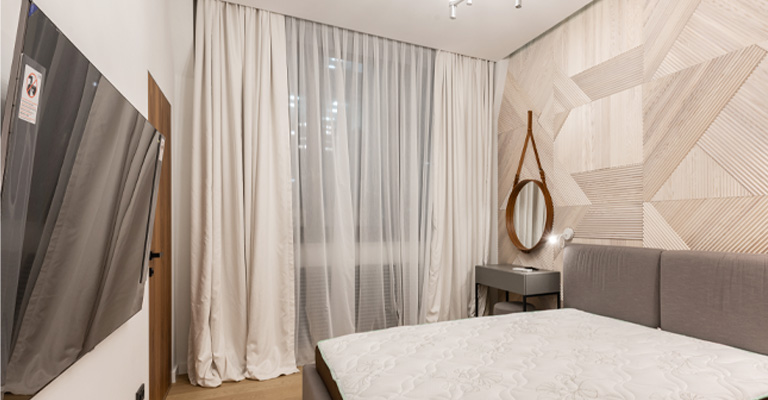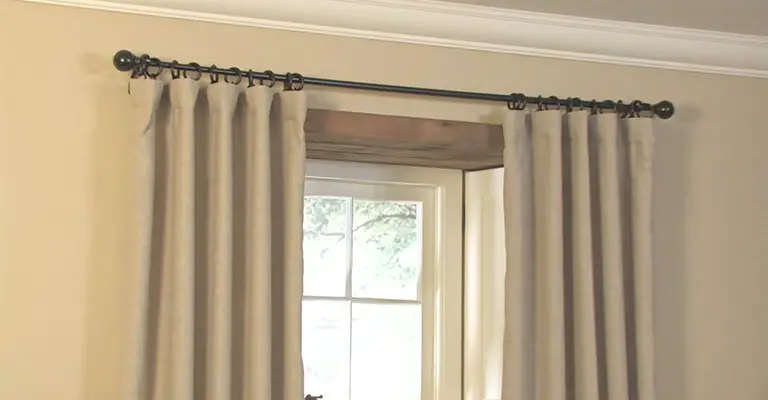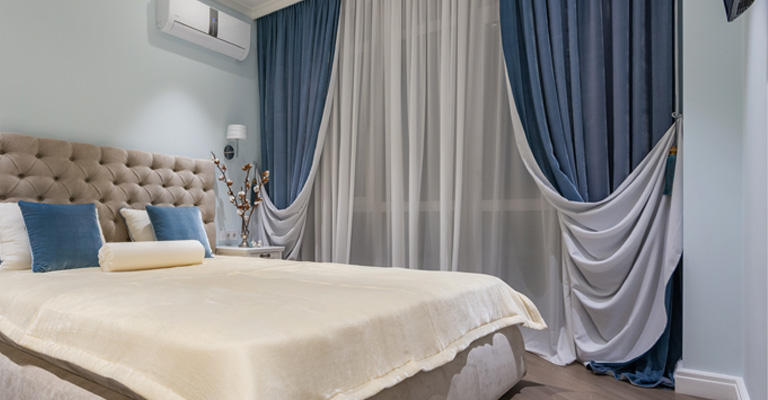Curtains are a fantastic way to add style and functionality to any room. They can transform the ambiance, control light, and offer a touch of privacy.
However, if you’ve ever purchased or inherited curtains that are too long for your windows, you know the struggle of dealing with excess fabric pooling on the floor.
Fortunately, you don’t have to settle for this less-than-ideal situation. In this guide, we’ll explore some simple hacks to solve the problem of curtains that are too long.
With a few easy adjustments and creative solutions, you can have perfectly tailored curtains that not only enhance your interior decor but also maintain their functionality.
How to Fold Curtains That Are Too Long?
Since curtains are expensive, you may not be in a hurry to replace them if you purchase a set that is too long accidentally.
If you walk in the room every time and see your curtains puddled on the floor, you likely won’t be too thrilled either.
The good news is that there are a few simple ways to trim your curtains to the perfect length—and you don’t even have to sew them.
Hack #1. Folding a Rod Pocket

From the top of the curtain, fold it twice down. It is important to fold the fabric towards the back of the curtain in order to prevent the pocket from showing through.
Things You Will Need:
- Straight pins or safety pins
- Iron-on hem tape
- Iron
- Ironing board
Step 1:
Once the first layer of fabric is glued down, make two folds. This will ensure that a pocket for the curtain rod remains.
Just fold the rod pocket over once if your curtains already have one—you’ll still have a pocket when you’re done.
It’s a good idea to fold the curtain twice as wide as the curtain rod you plan to use. If you do this, you will be able to easily install the curtain when you are done. The distance can be measured or eyeballed, depending on your preference.
Leaving a 1 inch (2.5cm) seam allowance is important if your curtains lack a rod pocket and you just want to fold them over once.
Step 2:
The pocket should be secured with pins. Using straight pins, or safety pins if you’d prefer, slide straight pins horizontally through the bottom of the fold.
By doing this, you will be able to form the bottom hem, but leave the pocket open for the rod to pass through.
Please stop here if you’re only looking for a temporary fix! It is just a matter of sliding the curtains onto the curtain rod and hanging them there.
Step 3:
You can fix the bottom fold without sewing by placing hem tape under it. On the ironing board, place a folded section of the curtain. Place an iron-on hem tape between the curtain and the innermost fold you made[19], then remove a few pins.
Ensure no adhesive is showing on your iron-if it touches the iron plate, it will stick to it and make a mess!
The curtains can also be stitched if you prefer. Use a heavy-duty sewing machine and work slowly. Do not sew up the sides of the pocket-you need it open. Instead, sew along the bottom of the fold.
Step 4:
To secure the hem tape, iron it. Your iron should be pressed down over the folded fabric and held in place for 1-2 seconds. After that, lift the iron straight up. Using this method, the hem tape will heat up, becoming adhered to the fabric.
When you have finished pressing and lifting that section, repeat the process for the next section. You should first check the care label on the curtain fabric to make sure it can be ironed.
You can test the iron on a low heat in an inconspicuous area, but since you won’t be pressing the iron to the fabric for very long, this will work on most fabrics. Place a cloth between the curtains and the iron before pressing it to the fabric.
Step 5:
Your pocket is ready for the rod. Slide it through. It is recommended that there is a gap between the second and third layers of folded fabric.
Using the curtain rod, you simply need to run it through this pocket. You can then hang your curtains normally!
Hack #2. Creating a No-Sew Hem

For ironing instructions, refer to the care label. It is possible to melt some synthetic fabrics when you iron them, while others will burn if you iron them at high temperatures.
Things You Will Need:
- Straight pins or safety pins
- Iron-on hem tape
- Iron
- Ironing board
- Measuring tape (optional)
Step 1:
On tags without any specific ironing instructions, look for a symbol that looks like an iron or a computer keyboard’s lowercase letter “A.”. It may look like:
A plain symbol — your iron is safe to use no matter what heat setting you use.
A symbol with 1 dot — use lowest heat possible.
A symbol with 2 dots — medium heat is recommended.
A symbol with 3 dots — set the heat to the highest level.
A symbol with an X — avoid ironing this fabric. If you want to adjust the length, consider creating a rod pocket or using curtain clips.
Step 2:
Ensure the curtains are the right length by folding the bottoms under. In order to do this, you have two options. If the curtains are hung, fold the bottoms under so they graze the floor.
If you want to measure the length from the top of the curtain rod to the floor, you can do so by measuring down from the top of the curtains. The fabric should be folded under the curtains or toward the back.
When you’re measuring the curtains, use a disappearing-ink fabric pen to make marks and fold them under to match.
You should also take into account the fact that curtains may be hung from clips or hooks. The curtains don’t need to be measured at all when you fold them while they’re hanging.
You may have a lot of excess fabric left over when you make curtains that are too long. When the curtains are finished, you can trim the excess material, but if you don’t want to cut them, make two to three folds to tuck it in nicely.
Step 3:
Make sure the hem is pinned in place. To secure the curtains, slide straight pins horizontally through the fabric as you fold them under. Do not worry if these pins show through the front of the curtains; you will remove them later.
Curtains can sometimes have a little more length on one side than the other. You should measure the curtain’s length from the top down several times along its width if you’re working by measurements.
Don’t start at the bottom and work your way up! When you use straight pins, you run the risk of them falling out. Instead, use safety pins.
Step 4:
Using an iron, create a crease by ironing over the fold, removing the pins as you go. The folded hem should be placed on your ironing board and heated to the desired temperature with your iron.
The iron should be run slowly along the bottom fold, but must not be ironed over the pins, as they may snag the fabric. You should remove straight pins with plastic heads carefully, as the plastic will melt if left in place.
In this case, you don’t need to take down the curtains if you pinned them while they were still hanging. Just place the ironing board directly under the window.
The top and bottom folds of the curtain need to be ironed if the curtain was folded over itself more than once.
You can keep the fold in place even without pins by ironing the crease down.
Step 5:
Hem tape can be ironed on to a folded hem when the hem is folded. Be sure to keep the tape close to the fold’s bottom if you folded it small or you intend to trim off the excess fabric.
If the curtain has been folded over onto itself several times, place the tape closer to the top crease so that it will lay flat when unfolded.
It is important to make sure that no tape is visible outside of the fold—a sticky mess will result if the adhesive touches the iron. If your ironing board doesn’t have enough room to iron the whole hem at once, you can do it in sections.
It’s totally fine to stitch them down if you are handy with a sewing machine. In spite of this, iron-on hem tape can help you achieve a neat hem if you aren’t a sewing expert!
Step 6:
To secure the tape, press and lift the iron over the fabric. The iron should be placed directly over the hem tape and pressed down for 1-2 seconds, then lifted straight up.
Repeat the process on the next section of adhesive by pressing down again with the iron. Make sure you go all the way down the curtain.
Make sure the fabric covers the adhesive completely. It’s important to avoid touching the iron plate with the hem tape.
In order to create a durable hem, the adhesive should stick to both sides of the fabric when heated.
Make sure you always press and lift when you are pressing. It would be best not to iron over the adhesive—you might pucker the fabric, which would make it difficult to remove.
Step 7:
If you wish, you can trim the excess fabric. The extra fabric that you folded up can now be trimmed with a sharp pair of fabric shears.
You want to cut slowly so you have a straight line, but don’t worry too much about it–the raw edge won’t be visible from the back.
Hack #3. Using Curtain Clips

Curtain clips with hooks or rings are the best choice.
Things You Will Need:
- Curtain clips
- Measuring tape (optional)
Step 1:
Clips for curtains have a small alligator clip on the bottom and either rings or hooks on the top. You can choose either style—it just depends on your style preferences.
In general, more clips give your curtains a more luxurious, pleated appearance, but you can use as many as you’d like per panel.
A curtain with fewer clips might seem stretched out, however. Because 9 clips make spacing super easy, we recommend using 9 clips per panel.
Purchase heavy-duty curtain clips if your curtains are made of heavy materials, such as velvet or brocade. For more information about the weight each clip can support, check the packaging or online product listing.
Step 2:
The top of the curtain should be folded over so it is the right length. Fold your curtains over from the top when you have measured the length you would like them to be. Curtains should be folded toward the back.
You won’t be able to see the fold on the front of your curtains, so there’s no need to worry about ruining their appearance!
Make sure that the tabs on your curtain that allow the rod to slide through them are cut off first with sharp scissors. Alternatively, the tabs may appear through the curtain if the sun shines on them.
Step 3:
Ensure the curtain clips are evenly spaced on the fold by clamping them on. With 9 clips per panel, you don’t have to measure to ensure that the clips are spaced perfectly.
The first clip should be placed on either end of the curtain, then the second one in the middle. There should be 1 clip exactly halfway between the leftmost clip and the center, and 1 clip halfway between the center and the right.
There should now be 5 in total. You will need to place each additional clip exactly halfway between the previous ones, resulting in nine clips in total.
Make sure that the clips are evenly spaced, no matter how many you are using. It will result in some areas of your curtains being too taut and others being too saggy.
Step 4:
Rings or hooks should be slid onto the curtain rod. You will need to feed the rod through each ring separately, then mount the rod on brackets if you are using rings.
It’s not necessary to take down the curtain rod if your clips are attached to hooks. Just slide the hook over the rod and it’s done.
Make sure your curtain rod’s last ring or hook is located outside the bracket so that your curtains do not slide too far when you close them.
Other Creative Ways to Shorten Long Curtains
Many of these ideas can be achieved without having to use the sewing machine, and they can be used for a wide range of curtains.
Raise the Rod
Depending on the wall space, shortening curtains can be accomplished as easily as raising the rod. If the fabric isn’t already exposed to all the glass, consider using a wider rod so it will expose the entire glass — maximizing natural light and view.
It is also possible to lift a window topper using the rod-raising method. There should only be a hem on the topper’s hem, so that every inch of the window below can be seen.
Shorten as Pleats or Scarves
By using pleating tape, you can reduce the sewing time when making ring-hung or tab-style curtains into pleated draperies. The excess material can also be brought up using decorative clips or buttons along the header.
Creating a window scarf from long, lightweight window treatments — or simply lifting the hems and draping them over the rod — is a relatively quick, creative solution to excessive length problems.
A Little Off the Top
Make tab-top or tie-style curtains grommet-hung by shortening them at least several inches. Tabs and ties should be cut off.
Using fusible thread or fabric adhesive, you can hem the back header area without sewing, or you can use fusible header web or grommet tape on the top.
There are some fabrics that can be damaged or stained by adhesive products, such as sheers and silks; alterations can be made using needle and thread, or you can use lightweight fusible web products, following the label guidelines.
Not only do grommets look good, but they also snap into evenly spaced holes, so no sewing is needed.
Tieback and Blouse
It is possible to give long curtains a little lift by placing the tiebacks in the right place. The fabric can be pulled up all around each panel if you mount one behind them instead of beside them.
In order to create an elegant look, blouse the curtain neatly in order to shorten the length. Clear monofilament or twine can be draped directly above each panel, centered directly above the rod.
The ends can be dangled from tieback height or higher or lower, as desired. The string ends are tied together to secure the look after one end is wrapped around the panel and the fabric hoisted to the desired height.
The Bottom Line
Certain curtains just make you want to hang them in your home for any reason, whether it’s their fabric, design, or color. Nevertheless, if the length isn’t right, it can be a problem. Fortunately, some simple solutions can solve this problem.
Using curtain clips or iron-on hemming tape to hem curtains that are too long is one of the best easy hacks for curtains that are too long. Additionally, you can raise the rod so that more space is available at the bottom of the curtains.








